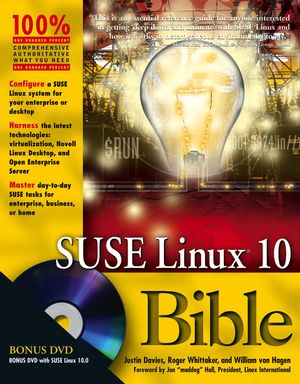SUSE Linux 10 BibleISBN: 978-0-471-75488-6
Paperback
912 pages
February 2006
 This title is out-of-print and not currently available for purchase from this site.
|
- The SUSE Linux X Bible will teach the reader how to run Linux on a SUSE desktop and in an enterprise environment. It will describe the best way to carry out a task while making full use of SUSE's configuration utilities and unique YaST modules. The coverage will apply across the full range of five SUSE products: the latest Enterprise Server (due end of summer 04), Professional (for home users and developers), OpenExchange Server (powerful email server with added groupware functionality, used as an corporate alternative to Microsoft Exchange), Standard Server (which competes with Microsoft’s Small Business Server) and Desktop (Enterprise desktop). Use of the very popular SUSE Linux OpenExchange Server will be explained thoroughly.
- New Material: a new chapter Novell Linux Desktop, Open Enterprise Server (Novell’s traditional environment running on SUSE), on virtualization including dosemu, wine, Crossover Office, uml xen and Vmware, expanded coverage of SUSE and sendmail, CUPS, LDAP and more.
- CD: An evaluation SUSE CD is available.
- Contents:
- The Basics: An introduction to SUSE Linux, basic Linux methodologies, including partitions, filesystems, filesystem layout etc.
- The SUSE System: SUSE specific methodologies. How to configure SUSE with the YaST management tools, including network configuration etc.
- The Command Line: Linux command line programs that would likely be used on a day to day basis. This includes text and file manipulation, network diagnostics etc.
- Implementing SUSE Linux: Using SUSE in environments such as mail, web, and file sharing. Providing the reader with detailed instructions on how to implement these services on SUSE in a reliable configuration.
- The Enterprise: An over view of SUSE in the enterprise, including the use of the SUSE Business products; Open Exchange, Open Enterprise Server and Novell Linux Desktop. The section also includes details on Enterprise architecture, and how Linux would be used in this scenario as well as Kernel recompilation and an overview of the SUSE maintenance process.



